Lard Help Me
This has to be one of the weirdest posts to transition to after last week’s post on vegan coconut fudge. I briefly mentioned in that post that I was in the process of doing something that would probably send most vegans running to the loo, or at least getting that nails on a chalkboard shiver down their spine. So, I do apologize to those non meat eaters out there who have come to read me for me veg-friendly recipes. This week, it’s probably best for you to look away and come back later. Because, you see, I’ve had it in my head to make my own lard for quite a while now, and after a trip to the Wooly Pigs stall at the University Farmer’s Market, I found myself coming home with a 10lb bag of pork fat. It was time to render.

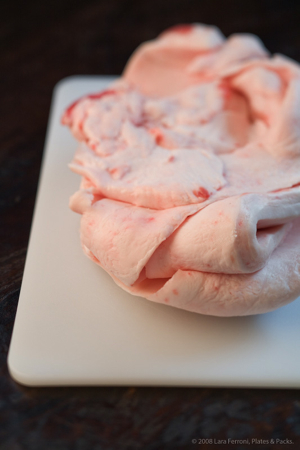
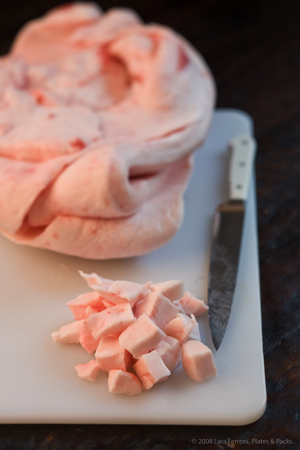
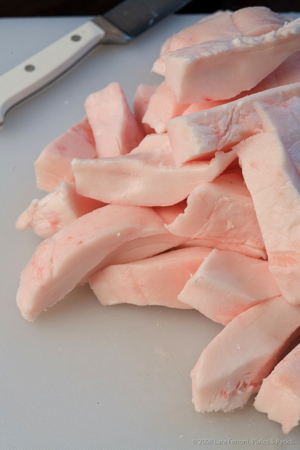
Of course, I really had no idea what I was doing, despite the fact that I had assured them at the booth that I did indeed know how to render lard. “Who doesn’t?” I might have joked. Well, me for starters. Luckily, I had resources.
I’ve been reading Matthew’s posts on lard now for quite some time, and I knew if I got myself into too much trouble, I could always give him a quick shout. There is also a great photo tutorial on rendering lard on Obsession with Food which helped considerably. So after a little while of staring down the intimidating looking bag, I dove in and started rendering following a kind of combination between the two different methods… I cubed rather than processed the lard, added a touch of water, and started it on the stove top. It was going, but quite slowly. Eventually, I decided to move it to a 250F oven, as Matthew suggests, and it started making more steady progress, eventually leaving me with about 4 or 5 quarts of fat with lots of cracklings.
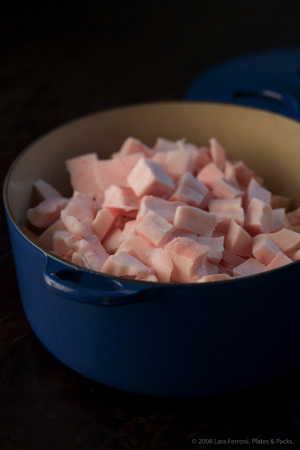
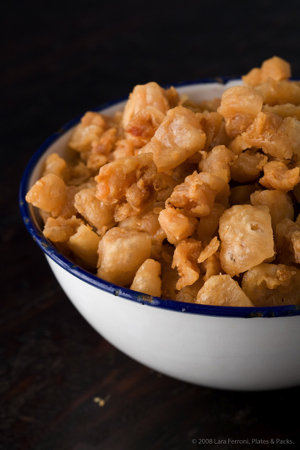
Once the lard was rendered, I had to figure out how to store it. I thought about jars, which seems to be the common choice. But after one quick disaster (do not try to pour hot lard into a jar, unless you like cleaning up a quart of liquid lard running all over and down your stove. Let’s just say my floors got an extra waxing), and realizing how much storage I was going to need in my freezer to hold all the lard and all those jars, I decided there might be a better way. What I really wanted were some pre-measured sticks of lard… something I could easily grab, cut up into little cubes for pastry, like I would a stick of butter. I needed to make sticks of lard.
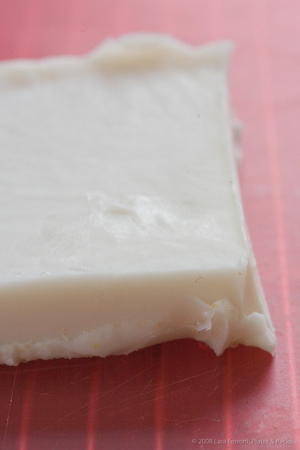
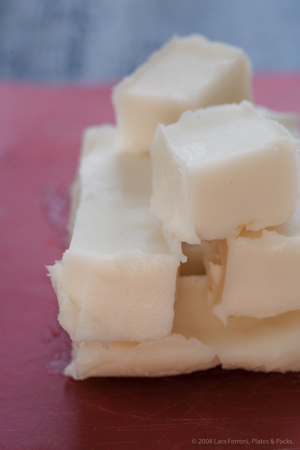
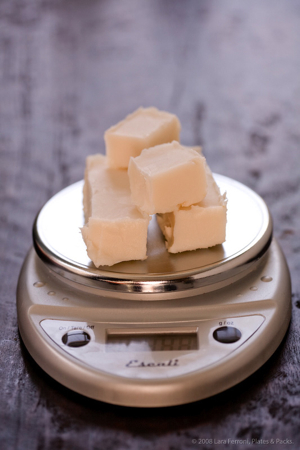
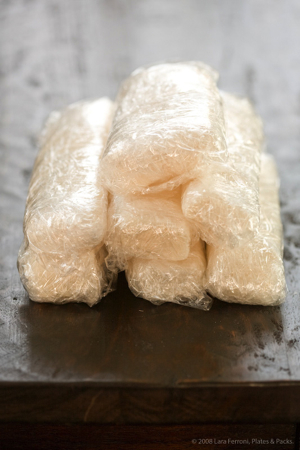
This turns out to be pretty easy to do. Just line a deep baking dish with plastic wrap, and pour the liquid (but not hot) lard into the dish so that it is about an inch or so thick. Cover with more plastic wrap and chill until it is solid. Then, use a spatula to carefully remove the lard from the tray onto a cutting board and cut out stick of butter sized pieces. I cut mine into 4oz blocks. The blocks are then easily double wrapped and stackable for the freezer.
Maybe you are wondering, much like my family, what I’m going to do with all this lard. Well, here’s a little hint of what’s to come:
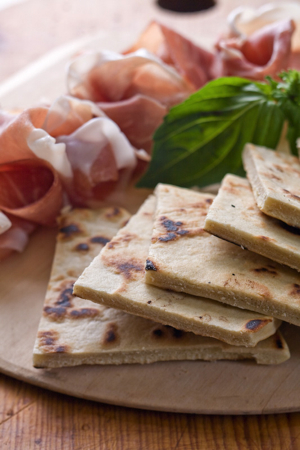
Technorati Tags: recipe
I love lard. Go on, make a great cornish pasty with it. steak and ale is a good bet, or steak and stilton.
Great looking photos as usual.
This has to be one of the more unusual blog posts I have read! But I must say very interesting. They did cook a lot with it in the “good ol’ days” I suppose. As usual, lovely pics.
OMG!! This was my childhood’s favourite! The version I had was deep-fried pork fat in little cubes that you did! Always an option to sprinkle some on top of noodles soup or stir-fry noodles! Health wise, it’s not good but it taste really good. I like the cripsiness!!
Thank you for sharing this 🙂
I’ve actually wanted to try doing this for a long time. Since I’ve heard that any lard that you buy at the grocery store has actually been processed so that it’s as full as trans fats as vegetable shortening, it seems the only way to get the real stuff is to do it yourself. Hope you try deep frying something in it 🙂
Happy valentine’s day!
I’ve occasionally thought of doing this, since the lard in the store has nasty preservatives in it, and I do love a good lard pie crust.
How were the cracklings?
Fantastic!
Since you have a lot of the stuff, make doughnuts. I guarantee they will be the best doughnuts you’ve ever tasted. I use the cake doughnut recipe from Cook’s Illustrated’s _Baking Illustrated_.
Another idea: snickerdoodles. Seriously. Find a snickerdoodle recipe calling for shortening and substitute lard.
I think this is the coolest, most unusual, “manly” post that I have read on the food blog circuit so far. I love it! I love everything about pork and lard is one of my favorites. I still remember eating stewed beans with lard when I was little. The pig skin still had some hairs on it and it was crunchy. Heavenly! I love you for this!
What a great project! I’ve only done lard once and it was completely worth it. I would recommend the tamales out of Rick Bayless’ Mexico One Plate at a Time as a homemade lard worthy recipe.
Make mincemeat. Homemade is the best!
Love the title of your post! Do the cracklings taste good? I seem to remember reading about them in one of the Little House on the Prairie books…
Pie crust! I’ve got home-rendered lard in my freezer but haven’t used it yet. I’m much a fan of a lard product from Canada that isn’t hydrogenated and so yes is lard that’s “good for you” (as is yours). I haven’t found anything similar here in St. Louis yet so am glad I bought five pounds in November!
Uh oh! Another thing to add to my “things to make” list. I already make my own mayonnaise, bread, yogurt, and chicken broth. Pretty soon my friends are going to think I’m some kind of weird Laura Ingalls Wilder reincarnation type. They already think I’m a little odd, so I point them to blogs like yours to show I’m not alone! Thanks for sharing.
Wow, just wow! I’m deeply inspired. But you didn’t say – how does it taste, I mean in comparison to store-bought stuff?
Hi, here in Spain where I live they make large use of Lard! There is even a cake that includes cracklings!
oh, lard. we keep a little tub of rendered bacon fat around, but it’s nowhere near this scale… i’m pretty jealous. i can’t wait to see it swing into action.
—Us vs. Food
Oh man…yea, WAY to transition! Yuck, that’s a little too much lard for me to handle.
This was really interesting. I have never even thought about doing this but you made it look very simple and worthwhile. Great storage idea. I can’t wait to see what’s to come.
Thanks for the informative post.
I love lard! When I was a kid I used it simply as a spread with salt and tomatoes. Ah those were some good days! My grandma used to make great scones using lard. Sadly, nowadays all those added preservatives make me avoid it. It’s great that you were able to make your own!
This is one of those things that I’ve toyed with the idea of trying but am far too terrified to actually do! What would one do with all the cracklings though?
Matt – I absolutely love a good pasty. Great idea!
Thanks Peter!
MyCookingHut – Sounds great! I’m sure the cracklings would have been really good on noodles. Thanks!
Nicole – I ran into the same thing when I needed lard for a recipe I was testing. I ended up buying hydrogenated, which of course, is terrible for you. That’s when I found out about leaf lard, and how much better it was. It’s really quite simple to make!
Jessamyn – They were tasty with some salt… although I ended up getting rid of them because by the time I was done rendering and cleaning up a whole lot of spilled lard, I was just kind of sick of it all and couldn’t imagine eating them. Now, though, I wish I head kept them!
Matthew – mmm. doughnuts.
Aran – wow. I think the hairs would be a bit much for me!
Charcuterista – Tamales are definitely a good idea. I think some tortillas are in the future too.
David – I can’t say I’ve ever thought about making mincemeat before… too many bad experiences as a kid with yucky storebought stuff. But, homemade might just do it for me!
Astrid – They were good, but I wasn’t quite in the mood for greasy things at that point (and they are pretty greasy).
Alanna – I couldn’t find anything that wasn’t hydrogenated when I was looking for lard… which inspired me to render my own. I’m guessing that if I had found the one that you had, I never would have… but I’m glad I did because the farm is such a great one, and I like knowing that.
TD – LOL. I know how you feel. I do get plenty of strange looks from my friends when I tell them what I’m making sometime.
Melissa – The only store bought stuff I found was hydrogenated, so it’s crap for you. Taste wise, I think mine has a bit more “pig” to it… but in the piadina that I’ve made so far, it was great. The jury is still out on using this batch for pie crusts… I think it will be good, but I’ll have to see.
Daniela – cool! I can’t quite imagine what that would taste like, but it sounds intriguing.
Michelle – Thanks… it should be fun!
Hillary – I understand! Thanks for stopping by anyway!
Ashley – thanks
Lore – hmm. Maybe I should make the bacon/cheddar scones I made with lard next time! As if the cream weren’t decadent enough 🙂
Ellie – It’s far easier than you probably think. You just need a big pot and a bit of time. There are lots of uses for cracklings. I know lots of folks who use them as bacon bits on salads. I tossed mine, but I probably should have done something with them.
That crackling looks amazing, well done. I’d use the lard to make delicious roast potatoes!
I am so impressed and I have never even thought of doing this. You are an inspiration to us all! WoW! Now, I want to try it because lard has soo much flavor and making fresh lard has to be outstanding in flavor compared to anything that is storebought. I have to admit that Fried Chicken is my all-time comfort food and frying it in lard and then making a homemade chicken gravy with the leftover bits in the iron skillet is a must. This homemade lard would take this dish to a whole new level. . .=D
You make lard look like taffy! Pork fat rules and home cooking rules! This was a great read and eye-candy post. Thanks!
Oh yeah, make tortillas!
Well well (or should I say lardy lardy?). I’ve never really thought of making my own lard; I can only imagine what your house smelled like both during the process and after your little lardy slip up. Look forward to lots of lardy recipes!
Ha! I did the exact same thing last month. Same leaf lard from Wooly Pigs. The cracklins have kept quite well in the fridge. Like you, I could barely look at them after rendering the lard, so I avoided them for a while. But now I’m enjoying them on plain rice with a bit of salt. Your pictures are stunning, by the way. I don’t remember my lard-making-extravaganza being being quite so pretty. On the other hand, you (wisely) didn’t post any pictures of the lard spillage :)….
I’ve never thought to make my own lard but what a great idea! though no doubt I would have to unplug my fire alarm first! can’t wait to see how you use it.
My mom has always fried french toast in bacon fat, and I can’t eat it any other way. Your post also reminds me of a food article I read once about making the best pie crust–with lard! I’ve been wanting to try it but forgot about it until I read your piece. Thank you for reminding me!
Thanks for this great post and information. I am getting ready to tackle some
real Southern Biscuits and want to make my own lard. Will find lots of other uses for baking as well. Appreciate you walking me through this.
It’s nice to know that people don’t think all Southern foods are horrible for you! I grew up in Eastern NC and we made our own lard by the “stand”. A stand was a 50 lb metal canister. You are right about how good things are when cooked or made with lard. You are however sadly lacking in crackling info! Cracklings need to be pressed to remove some of the excess grease. While they are hot, simply put a plate on top of them and MASH. Pour off the excess grease. Then make a thin cornbread batter, fill it will some of the cracklings, and bake until crispy and crunchy. Crackling cornbrea is a true Southern staple. Cracklings are also good in biscuits (cut down on the lard some), liver pudding, etc. Oh, and add a fresh bayleaf to your lard while it is hot, remove it before making the sticks. It gives a wonderful flavor!
Great post–I’ve also gotten leaf lard from Wooly Pig, and I render lard by putting it in a 200 degree oven (I have a large perforated pan where I keep the lard and a large pan underneath to catch the drippings. Your idea on storage is perfect–I will just cool the pan and cut up the lard into chunks as you suggest.
With regard to the cracklings, did you squeeze them and cook them further (that is what the guy at University Farmer’s Market said to do)–the last time I made lard, I just threw the cracklings away. What did you do with the cracklings?
About the crackin’s – salt them and put them on salads or use them for snacking. They are a great low carber snack in place of popped corn. You can put garlic salt, black pepper, and chili powder on them too.
John 3:17.
This site brought back a lot of memories. I was fortunate enough to have experienced hog butchering in person (mid-late 60s/early 70s) and before anyone asks I was about 6 for my first experience and about 14 for my last exposure. My brother and I still talk about the day after butchering, when my grandfather and my dad would take all of the left over fat and put it in a large cast iron black pot. Its been a long time ago, but I would day it was in the 10-20 gallon range and they would cook it over an open fire. The key they always said was to never let it smoke..and it would take hours. After it was done my grandfather would transfer it to a lard can (5 gallons) and let it cool. My dad would always dump a bag of popcorn in the pot when we were done and let it pop, lots of salt..it is a favorite memory. The cracklin’s were outstanding. When I was younger my parents restricted me as they said they were too rich (fatty) but as I got older I was allowed to eat as many as I wanted. By this time I was working construction with my dad and we would leave them on the dash of truck and let the sun heat them and we would snack on them all day long. Just one point that I want to make after reading through the posts. My grandmother kept the lard can in a cabinent and used it for almost every meal. I look back now and wonder how long she was able to keep it. On other thing cracklin cornbread is a dish I will always remember. Basically it was cornbread with cracklins mixed in.
Hi, I stumbled onto your blog through a search engine while trying to learn how to render lard. I thought that mine was supposed to be as white and shelf stable as the commercial stuff, as it turns out, I’ve been hitting it pretty close all along. I have been told though, if lard is properly rendered and processed, that it will keep for up to a year without refridgeration. I hope that you and your readers will find some usefull information in the lines that follow.
I started cooking cracklings in 2005 as a means of seasoning my cast iron pots, and I like to snack on “cracklins” as we call them in south Louisiana. My family roots are in southeast Louisiana, about 25 miles from Mississippi. I have since started (partially resumed would be more accurate) a tradition of cooking cracklins at our Thanksgiving celebration. My elders tell me that “Thanksgiving day was hog killin’ day” when they were growing up on the farm where they raised most of their food. They have memories, some fond, some not so fond, of killing, butchering, and processing their own pork. It is amazing, the stories and lessons that can come out while standing around a washpot (iron kettle) of cracklins over a wood fire, which is now the main reason that I do it, and, at the end of the day, those who want them have plenty of cracklins to take home because I cook 20 to 30 pounds.
We like to put a few in a pot of mustard greens, turnips, snap bean (green beans), or any other vegatable that you would put bacon in. Try crumbling the cracklins in your favorite cornbead recipe, for cracklin bread I don’t add sugar to the batter. We like them best, straight out of the pot and sprinkled with a little creole seasoning or “Old Bay” along with a cold beer while we sit and talk, around the fire that they were cooked over.
I understand that to store your lard, you should add an equal amount of clean water to the pot, after removing the cracklins and it cools (to avoid a violent reaction) and bring it slowly to a boil, then remove it from the fire and allow it to cool completely (may take overnight), remove the fat(which should be solid) from atop the water, repeat the boiling and cooling process once more with clean water, your lard should now be clean and ready to package in whatever manor you see fit.
I apollogize for the length of the story, it’s just the way we communicate in the south, besides, if you intend to render your own lard, now is a good time to get out of a hurry!